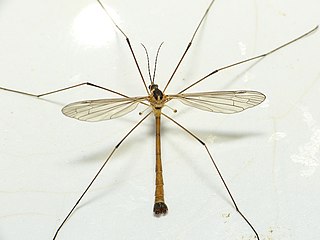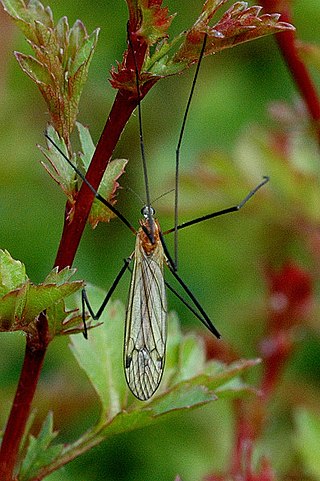
Quercus robur, commonly known as common oak, pedunculate oak, European oak or English oak, is a species of flowering plant in the beech and oak family, Fagaceae. It is a large tree, native to most of Europe west of the Caucasus. It is widely cultivated in temperate regions elsewhere and has escaped into the wild in scattered parts of China and North America.

Crane fly is a common name referring to any member of the insect family Tipulidae. Cylindrotominae, Limoniinae, and Pediciinae have been ranked as subfamilies of Tipulidae by most authors, though occasionally elevated to family rank. In the most recent classifications, only Pediciidae is now ranked as a separate family, due to considerations of paraphyly. In colloquial speech, crane flies are sometimes known as "mosquito hawks", "skeeter-eater", or "daddy longlegs",. The larvae of crane flies are known commonly as leatherjackets.

Frederick William Hope was an English clergyman, naturalist, collector, and entomologist, who founded a professorship at the University of Oxford to which he gave his entire collections of insects in 1849. He described numerous species and was a founder of the Entomological Society of London in 1833 along with John Obadiah Westwood.

Glover's Wood is a 74.5-hectare (184-acre) biological Site of Special Scientific Interest east of Charlwood in Surrey. It is a Nature Conservation Review site, Grade 2.

Tipula is a very large insect genus in the fly family Tipulidae. The members of this genus are sometimes collectively called common crane flies. Tipula contains over 2,000 species located throughout the world.

Pertica is a genus of extinct vascular plants of the Early to Middle Devonian. It has been placed in the "trimerophytes", a strongly paraphyletic group of early members of the lineage leading to modern ferns and seed plants.

Pedicia rivosa is a species of hairy-eyed cranefly in the family Pediciidae. It is found across most of Europe, but excluding the Iberian Peninsula. The subspecies P. r. mannheimsi is found in France and Germany, and some specimens from Scotland may also belong to this subspecies.

Dictenidia bimaculata is a species of cranefly which is widespread throughout the Palaearctic.

Tipula paludosa is a species of true craneflies, family Tipulidae. It is also known as the European crane fly or the marsh crane fly. It is a pest in grasslands of Northwest Europe and has been accidentally introduced to North America.

The Cylindrotomidae or long-bodied craneflies are a family of crane flies. About 115 species in 9 genera occur worldwide.

The Cylindrotominae are a subfamily from the family Cylindrotomidae. These flies are closely related to true crane flies.

The Fly-class river gunboats, collectively often referred to as the "Tigris gunboat flotilla", were a class of small well-armed Royal Navy vessels designed to patrol the Tigris river during the Mesopotamian Campaign during the First World War.

Limonia nubeculosa, also known as the short-palped cranefly, is a species of crane flies in the family of Limoniidae.

Phylidorea ferruginea is a Palearctic species of craneflies in the family Limoniidae.It is found in a wide range of habitats and micro habitats: in earth rich in humus, in swamps and marshes, in leaf litter and in wet spots in woods.

Limnophila schranki is a cranefly in the family Limoniidae.

Austrolimnophila ochracea is a cranefly in the family Limoniidae. It is a Palearctic species with a limited distribution in Europe It is found in a wide range of habitats and micro habitats: in earth rich in humus, in swamps and marshes, in leaf litter and in wet spots in woods.

Erioconopa trivialis is a Palearctic species of cranefly in the family Limoniidae. It is found in a wide range of habitats and microhabitats: in earth rich in humus, in swamps and marshes, in leaf litter and in wet spots in woods.

Rhipidia maculata is a Palearctic species of craneflies in the family Limoniidae.It is found in a wide range of habitats and micro habitats: in earth rich in humus, in swamps and marshes, in leaf litter and in wet spots in woods.
Limonia hardyana or flightless crane fly is a rare, wingless fly living in leaf litter on Oʻahu.

















